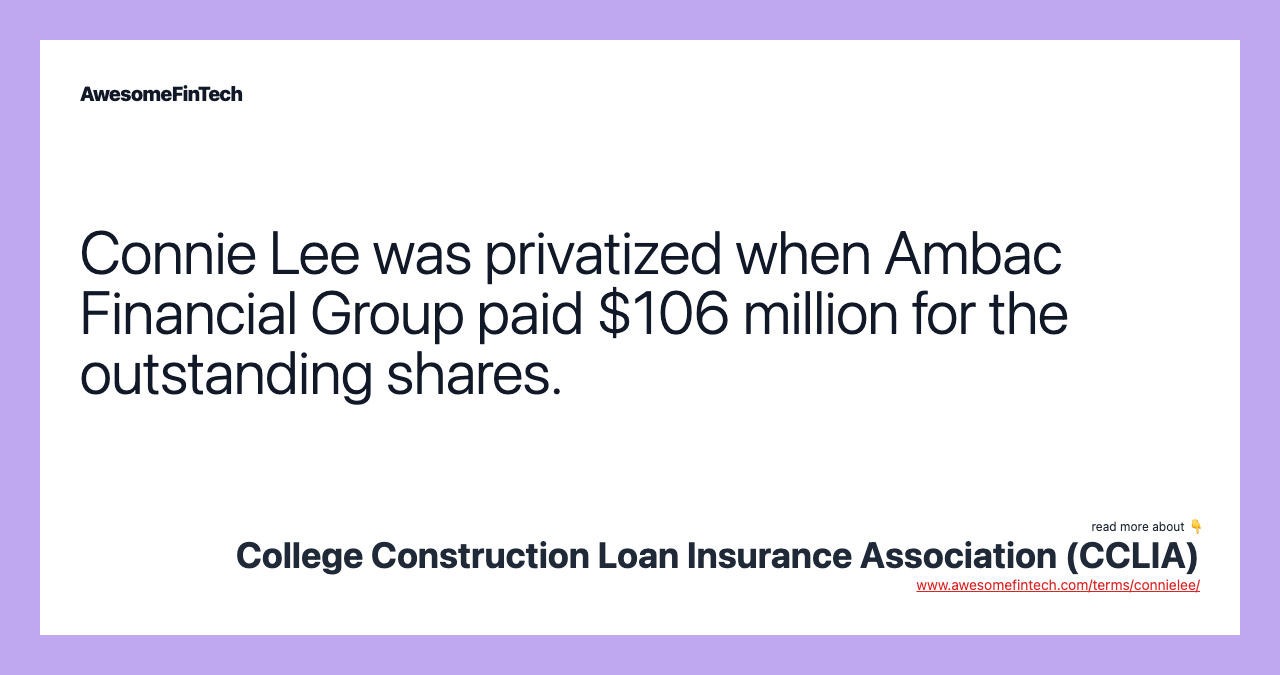College Construction Loan Insurance Association (CCLIA)
The College Construction Loan Insurance Association (CCLIA), nicknamed Connie Lee, was a government-sponsored enterprise (GSE) created by the Higher Education Amendments of 1986. In being referred to as Connie Lee, the College Construction Loan Insurance Association was following the same scheme as other government-sponsored enterprises (GSEs), such as Sallie Mae (originally titled the Student Loan Marketing Association), Fannie Mae (the Federal National Mortgage Association), and Freddie Mac (the Federal Home Loan Mortgage Corp). The Department of Education provided Connie Lee with start-up equity capital when it was incorporated in 1987, but Connie Lee always found itself caught in between conflicting federal and state laws on insuring bonds. The College Construction Loan Insurance Association (CCLIA), nicknamed Connie Lee, was a government-sponsored enterprise (GSE) created by the Higher Education Amendments of 1986. However, state laws constrained bond insurance companies like Connie Lee to have a specified percentage of their business — often as much as 95% — in investment-grade categories of debt: bonds rated BBB and above.

What Was the College Construction Loan Insurance Association (CCLIA)?
The College Construction Loan Insurance Association (CCLIA), nicknamed Connie Lee, was a government-sponsored enterprise (GSE) created by the Higher Education Amendments of 1986. Connie Lee’s purpose was to provide insurance for construction projects undertaken by universities, colleges, teaching hospitals, and other educational institutions. It was privatized in 1997.
From October 1991 — when it insured its first bond — through September 1995, Connie Lee insured 95 bonds totaling about $2.6 billion. Many were for historically black colleges and universities. It remained in sound financial shape throughout its short life.





How CCLIA Worked
Connie Lee provided backing for the debt instruments educational institutions would issue in order to help fund new or renovated buildings and facilities. Technically a for-profit bond insurance holding company, authorized by federal statute, it mainly insured municipal bonds issued by schools whose debt had relatively low credit ratings — Standard & Poor's ratings of BBB and below.
The Department of Education provided Connie Lee with start-up equity capital when it was incorporated in 1987. But from the beginning, the enterprise was caught between two conflicting mandates. Federal law generally limited it to insuring bonds that were greater credit risks: a rating of BBB or below. However, state laws constrained bond insurance companies like Connie Lee to have a specified percentage of their business — often as much as 95% — in investment-grade categories of debt: bonds rated BBB and above.
Furthermore, many institutions of higher education did not need to issue bonds or obtain bond insurance to finance projects, relying on endowments, alumni gifts, or other federal sources instead.
As a result, although authorized to operate in 49 states, the District of Columbia, and
Puerto Rico, Connie Lee ended up being able to serve a rather narrow number of schools. After the Higher Education Amendments of 1992, it was allowed to insure higher-grade debt, broadening its range somewhat.
Privatization of Connie Lee (CCLIA)
By June 1995, talks were underway to take Connie Lee private, and a Congressional bill, the College Construction Loan Insurance Association Privatization Act of 1995, was passed, ending its federal sponsorship.
In November 1997, Reuters reported that bond insurer Ambac Financial Group paid $106 million for the outstanding shares of Connie Lee. According to news reports at the time, Connie Lee’s largest shareholders were Sallie Mae, with 42% of its stock, and the Pennsylvania Public School Employees Retirement System, at nearly 23%. Ambac also paid down $18.4 million in debt that Connie Lee incurred when it bought back the 14% stake the U.S. Treasury Department had in it.
The acquisition came after a period of speculation during which Connie Lee waited for a buyer and new leadership. The company's founding president and CEO Oliver Sockwell had retired earlier in the year. Ambac renamed its new subsidiary the Connie Lee Insurance Company. However, it remained dormant, writing no new insurance policies for years.
In 2008, Ambac received regulatory approval to capitalize and reactivate Connie Lee, refocusing it on college and hospital infrastructure projects with an injection of $850 million in capital. Much of the public debt that was financed has been in run-off. This means that the insurance company will allow the existing bonds to mature, but no new issues will be generated.
Connie Lee and Other Government-Sponsored Enterprises
Related terms:
Accounting
Accounting is the process of recording, summarizing, analyzing, and reporting financial transactions of a business to oversight agencies, regulators, and the IRS. read more
Bond : Understanding What a Bond Is
A bond is a fixed income investment in which an investor loans money to an entity (corporate or governmental) that borrows the funds for a defined period of time at a fixed interest rate. read more
Endowment
An endowment is a nonprofit's investable assets, which are used for operations or programs that are consistent with the wishes of the donor(s). read more
Feasibility Study : How Does It Work?
A feasibility study analyzes all relevant factors of a project to determine the possibility and probability of completing it successfully. read more
Federal Home Loan Bank (FHLB) System
The Federal Home Loan Bank (FHLB) System is a consortium of regional banks created to keep cash flowing to the nation's lending institutions. read more
Freddie Mac—Federal Home Loan Mortgage Corp. (FHLMC)
Freddie Mac (the Federal Home Loan Mortgage Corp.) is a government-sponsored enterprise that purchases, guarantees, and securitizes home loans. read more
Government National Mortgage Association (Ginnie Mae)
Ginnie Mae is a federal government corporation that guarantees securities that underwrite mortgages, helping lenders serve more homeowners read more
Government-Sponsored Enterprise (GSE)
A government-sponsored enterprise (GSE) is a quasi-governmental entity that enhances the flow of credit to specific economic sectors by providing public financial services. read more
Investment Grade
Investment grade refers to bonds that carry low to medium credit risk. read more
Perkins Loan
From 1958-2017, Perkins loans provided low-interest loans to undergraduate and graduate students who demonstrated exceptional financial need. read more